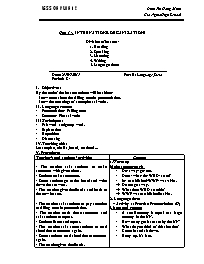Giáo án Tiếng Anh Lớp 12 - Unit 14: International organizations - Period 84: Language focus - Năm học 2014-2015 - Đinh Thị Hồng Minh

I. Objectives:
By the end of the lesson students will be able to:
+ know more about the falling tune in pronunciation.
+ know the meanings of some phrasal verbs.
II. Language content
- Pronunciation: Falling tune
- Structure: Phrasal verbs
III. Techniques:
- Pair work and group work.
- Explanation
- Repetition
- Discussing
IV. Teaching aids:
Lesson plan, chalks, board, textbook.
V. Procedure:
Bạn đang xem tài liệu "Giáo án Tiếng Anh Lớp 12 - Unit 14: International organizations - Period 84: Language focus - Năm học 2014-2015 - Đinh Thị Hồng Minh", để tải tài liệu gốc về máy bạn click vào nút DOWNLOAD ở trên
Unit 14: INTERNATIONAL ORGANIZATIONS Division of lessons: 1. Reading 2. Speaking 3. Listening 4. Writing 5. Language focus ___________________________________________________________ Date: 23/03/2015 Part E: Language focus Period: 84 Objectives: By the end of the lesson students will be able to: + know more about the falling tune in pronunciation. + know the meanings of some phrasal verbs. Language content Pronunciation: Falling tune Structure: Phrasal verbs Techniques: Pair work and group work. Explanation Repetition Discussing Teaching aids: Lesson plan, chalks, board, textbook... V. Procedure: Teacher’s and students’ activities Content - The teacher asks students to make sentences with given clues. - Students make sentences. - Some students go to the board and write down the answers. - The teacher gives feedbacks and leads to the new lesson. - The teacher asks students to pay attention to falling tune in pronunciation. - The teacher reads these sentences and asks students to repeat. - Students listen and repeat. - The teacher asks some students to read aloud these sentences again. - Some students read aloud these sentences again. - The teacher gives feedbacks. - The teacher tells students meanings of some phrasal verbs. - Students listen and take notes. - The teacher asks students to work in pairs to do the task. - Students do the task with their partners. - The teacher asks some students to give answers orally. - Some students gives answers. - The teacher gives feedbacks. - The teacher asks students to work in pairs to do the task. - Students do the task with their partners. - The teacher asks some students to go to the board to write down the answers. - Some students go to the board and write down the answers. - The teacher checks the answers. - Students look at the board, listen and take notes. - The teacher asks students to work in pairs to do the task. - Students do the task with their partners. - The teacher asks some students to go to the board to write down the answers. - Some students go to the board and write down the answers. - The teacher checks the answers. - Students look at the board, listen and take notes. 1.Warm up Make sentences: (4) Do/ away/ go/ not. Does/ what/ for/ WHO/ stand? In/ established/ WWF/ was/ 1961. Do not go away. What does WHO stand for? WWF was established in 1961. 2. Language focus * Activity 1: Practise Pronunciation (8’) Listen and repeat: A small country is equal to a large country in the UN. How many goals are set by the UN? What do you think of this situation? Come in and sit down. Hurry up. It’s late. * Activity 2: Phrasal verbs (10) - fill in (phr) - look up (phr) - give up (phr) ≈ stop (v) - put on (phr) # take off (phr) - turn on (phr) # turn off (phr) - wash up (phr) - go on (phr) ≈ continue (v) - look after (phr) ≈ take care of (phr) - take after (phr) ≈ look like (phr) - get over (phr) ≈ recover from (v) * Activity 3: Exercise 1 (7) 1.give up 2. fill in 3. turn on 4. take off 5. wash up 6. look up 7. turn off 8. fill in 9. go on 10. put on * Activity 4: Exercise 2 (7) 2. up 3. out 4. round 5. on 6. up 7. down 8. away 9. down 10. on * Activity 5: Exercise 3 (8) 2. look after 3. takes after 4. got over 5. held up 6. try out 7. went off VI. Comments
Tài liệu đính kèm:
 giao_an_tieng_anh_lop_12_unit_14_international_organizations.doc
giao_an_tieng_anh_lop_12_unit_14_international_organizations.doc





